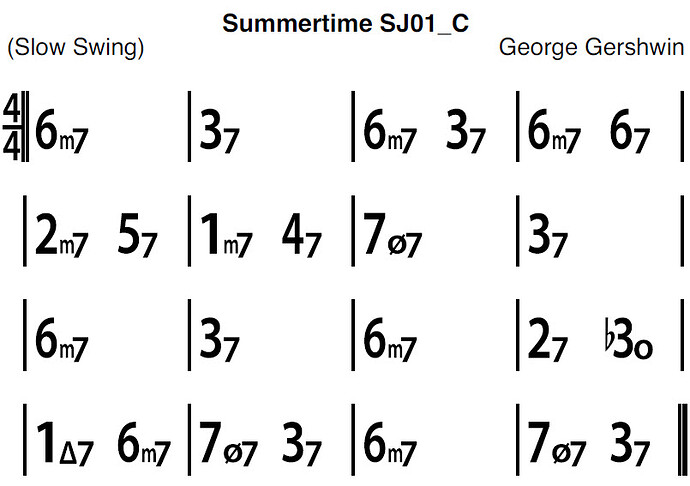Thanks to @sj1 for the great question and also to everyone else for their thoughtful replies. I love the atmosphere of friendship and respect in this forum! The only clarification I should add in terms of the IFR method itself is that IFR has no preference for either form of analysis. As I often say, all harmonic analysis is subjective. I know it doesn’t always feel subjective, because some songs are so simple that it seems like there is only one rational way to analyze them. But even that is an illusion. Any song in the world can be analyzed in any key you like.
For example, you’ve already hit on two of the most useful and illuminating metaphors for analyzing Summertime. That opening chord can be called 6-, which causes many other chords of the song to appear as old familiar friends (e.g. the 1 chord, the 2- chord, etc.). Or we could call that opening chord 1-. This requires us to deal with the somewhat more complex idea of a “minor scale”, but it does give us the nice benefit that our tonal center is called “note 1”, which seems like a sane way to refer to our tonal center.
But none of this is right or wrong. You could also call that opening chord #4-. The rest of your harmonic analysis would become a train wreck full of obtuse and unfamiliar chords. But it wouldn’t be “wrong”. It would just be unhelpful and unnecessarily complicated.
So in terms of IFR, it’s not that the 6- chord concept is “better” than the 1- chord concept. It’s not a question of better. It’s a question of which model to learn FIRST. Because almost every song in the world makes use of multiple chords from the same major scale, the single most empowering thing we can do for ourselves as beginning improvisers is to learn to see these references to the major scale in the music all around us. But music is a creative art form, and so abstraction is the rule rather than the exception. This means that no matter how enthusiastically you embrace the 6- concept that IFR seems to prefer, composers will always come along to frustrate your attempts to understand their works of art with just that concept.
So there are two dynamics to understand here. One is the teaching dynamic. Here, we have no preference between 1- and 6-. Both concepts are important and we eventually want to master both. But we do have a clear preference for which concept to teach first. For a multitude of reasons that I could defend until you all drop dead from boredom, 6- is the right concept to teach first (in my humble opinion).
But the other dynamic to understand is that of harmonic analysis itself. Here’s it’s important to understand the DIRECTION of analysis. It’s always problematic to take a real world song and force it backwards into the world of theory. Maybe that opening chord isn’t the 6- chord or the 1- chord at all! What if the composer treats it like a 6- chord in some ways, but then includes the note #4 producing the dorian sound? Does it then become a 2- chord? None of these questions have answers.
But what we CAN do is study music in the opposite direction. Learn the metaphors of the major scale. Study the seven harmonic environments, the seven chords, and then the entire path outward into Mixed Harmony. Learn to see these shapes and tonal fragments in the music all around you.
It’s no different from learning simple geometric shapes like circles, triangles and squares. You shouldn’t become paralyzed when you see a house or other object that cannot neatly be labelled as either a circle, triangle or square. But those geometric shapes still have meaning and value. Study them, understand their properties, and you’l see examples of them all around you. Maybe that house can be best understood as a triangle sitting on top of a square. And THAT is the proper analysis.
The same happens in music. And so we can certainly discuss our favorite models for understanding Summertime. But we can’t ever say that Summertime IS one particular model or another. So there’s no right or definitive answer to the question of how to think about Summertime. But the more we study harmony, the more familiar shapes and concepts we can spot when we study a tune like Summertime.
Sorry for the long answer. The TLDR is that in IFR, we first seek to master basic tonal harmony and then we journey outward into the world of abstractions. The 6- chord is a more fundamental concept so that would get studied first. But sometimes it’s out in the more abstract concepts that you find the most empowering tools. So I would always encourage you to look at every song from all angles and to feel perfectly empowered to create your own mental model for thinking about the harmony.


